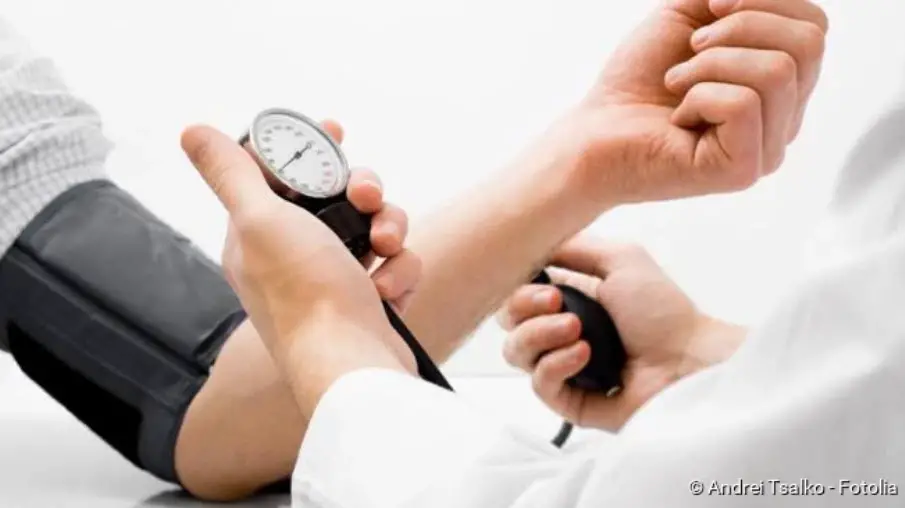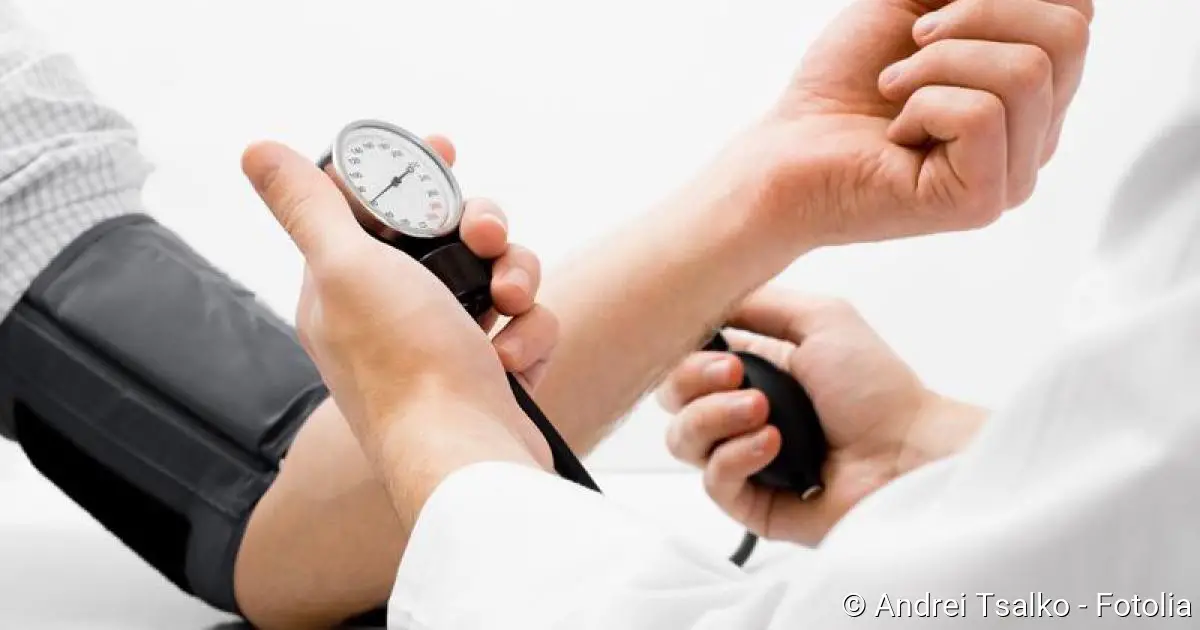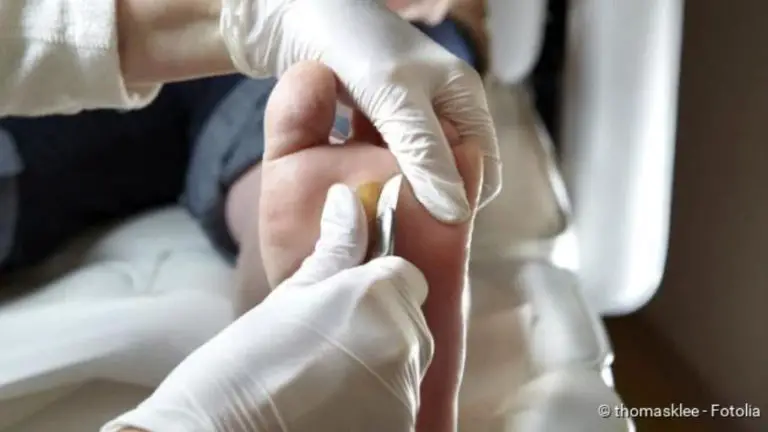Hypertension: symptoms, causes and therapy
Hypertension: symptoms, causes & therapy
High blood pressure (hypertension) is a widespread disease. In the long run, high blood pressure damages the vessels and thus contributes to the development of secondary diseases such as heart attack and stroke. Here you can read everything important about the causes, symptoms, dangers and treatment of hypertension!

High blood pressure: short overview
- Definition of hypertension: blood pressure > 140/90 mmHg
- Possible consequences: Coronary heart disease, cardiac insufficiency, heart attack, stroke, pAVK, retinal damage, kidney damage, etc.
- Common symptoms: headaches (especially in the morning), dizziness, slight fatigue, reddened face etc.; possibly also symptoms of secondary diseases such as chest tightness (angina pectoris), water retention in the tissue or visual disturbances
- Treatment: lifestyle change (lots of exercise and sport, weight loss, healthy diet, smoking cessation, etc.), possibly antihypertensive drugs; treatment of the underlying disease in secondary hypertension
- Caution: In the event of a sudden, massive rise in blood pressure with signs of organ damage (hypertensive emergency), immediately alert the emergency doctor (emergency number: 112)!
Hypertension: Definition
In case of high blood pressure (hypertension), the blood pressure values are permanently too high. Blood pressure values are created because blood is pumped from the heart into the blood vessels with every heartbeat. The blood exerts pressure on the vessel wall from the inside. Depending on the heart action, two blood pressure values are distinguished:
- Systolic blood pressure: It occurs during the phase in which the heart contracts (systole) Blood is pumped from the heart into the main artery (aorta). The resulting pressure wave continues over the vessel walls of the arteries. As a result, a pulse wave can be measured even in more distant body regions (such as arms and legs).
- Diastolic blood pressure: In diastole, the heart muscle expands to fill with blood again. There is still a pressure in the vessels, but it is lower than the systolic blood pressure.
The blood pressure of every person is subject to certain fluctuations. For example, excitement and physical exertion cause blood pressure to rise, while it can be significantly lower at rest or during sleep. These fluctuations in blood pressure are normal and are used for physical adaptation to the situation. In healthy people, the blood pressure values always settle back into the normal range. Only when the blood pressure is permanently too high does it need to be treated.
By the way: The term high blood pressure is usually used in the sense of arterial hypertension, i.e. elevated blood pressure values in the body’s circulation as described here. There are, however, other forms of hypertension, such as high blood pressure in the pulmonary circulation (pulmonary hypertension, pulmonary hypertension). This text here deals only with arterial hypertension.
High blood pressure values
The unit of measurement for blood pressure is mmHg (millimetres of mercury). For example, a reading of 126/79 mmHg (i.e. 126 to 79) means that the systolic blood pressure is 126 and the diastolic is 79 mmHg. Physicians describe values of less than 120 mmHg systolic and less than 80 mmHg diastolic as optimal blood pressure. In addition, the following reference ranges for blood pressure apply:
| Scale division | Systolic | Diastolic |
| Normal | 120-129 mmHg | 80-84 mmHg |
| High Normal | 130-139 mmHg | 85-89 mmHg |
| Hypertension grade I
(mild hypertension) |
140-159 mmHg | 90-99 mmHg |
| Hypertension grade II
(moderate hypertension) |
160-179 mmHg | 100-109 mmHg |
| Hypertension grade III
(severe hypertension) |
≥ 180 mmHg | ≥ 110 mmHg |
| Isolated systolic hypertension | ≥ 140 mmHg | < 90 mmHg |
Isolated systolic hypertension is a purely systolic high blood pressure. The diastolic blood pressure is lowered. The cause is, for example, a malfunction of the aortic valve (one of the heart valves).
High blood pressure: dangers
In the long run, high blood pressure damages important organs such as the heart and its supplying vessels (coronary arteries), the other blood vessels, the brain and the kidneys. This can cause life-threatening diseases.
High blood pressure can damage various organs in the long term and have life-threatening consequences. The heart and coronary vessels, the brain, the eyes and the kidneys are most frequently affected.
In the area of the heart, high blood pressure can promote arteriosclerosis (calcification of the coronary arteries). This coronary heart disease (CHD) can lead to cardiac insufficiency (heart failure) or cardiac arrhythmia. A heart attack is also possible.
Strokes occur more frequently in the brains of hypertensive patients than in healthy people. The circulatory disorders caused by high blood pressure can also affect the smallest vessels of the brain (microangiopathy). This results in a chronic undersupply of oxygen and nutrients to the brain tissue. It impairs brain performance and promotes early mental deterioration (vascular dementia).
Over time, the vascular damage caused by high blood pressure also affects the kidneys and their function: possible consequences are chronic kidney weakness (chronic renal insufficiency) and even kidney failure.
The circulatory disorders that develop as consequences of high blood pressure also have a negative effect on other parts of the body. For example, peripheral arterial occlusive disease (pAVK) can develop in the legs. In the eyes, the retina is damaged, which affects vision. Doctors speak of hypertensive retinopathy.
The constant pressure load in the vessels can lead to the formation of aneurysms in the vessel wall. They can burst and cause life-threatening internal bleeding. A particular danger is posed by aneurysms in the area of the aorta (aortic aneurysm) and in the brain (a bursting brain aneurysm causes a hemorrhagic stroke).
Benign and malignant hypertension
It used to be called “benign (essential) hypertension” if no crisis-like deterioration of blood pressure (exacerbations) occurs during the course of the disease. Many experts now reject this term because “benign” hypertension is also very dangerous and has an increased mortality rate.
As a counterpart to benign hypertension, the term “malignant” (malignant) hypertension was coined. It is defined by constant massive high blood pressure (diastolically mostly > 120 mmHg), which, if untreated, leads to death in 95 percent of those affected within five years.
Hypertensive crisis
In a hypertensive crisis (high pressure crisis), blood pressure suddenly rises dramatically to values above 230 mmHg (systolic) and/or 130 mmHg (diastolic). This can cause headaches, dizziness, nausea and vomiting, for example. If there are signs of organ damage due to the massive rise in blood pressure (such as angina pectoris), this is called a hypertensive emergency. Then there is danger to life and the emergency doctor must be alerted immediately (emergency number: 112)!
A hypertensive crisis is usually observed in patients with chronic high blood pressure. It rarely occurs in people whose blood pressure values are otherwise normal. The trigger can then be, for example, an acute inflammation of the renal corpuscles (acute glomerulonephritis).
You can read more about the development, symptoms and treatment of the hypertensive crisis in the article Hypertensive crisis.
High blood pressure: Symptoms
Most patients hardly show any clear symptoms of hypertension, so the increased vascular pressure often goes unnoticed for a long time. High blood pressure is therefore a “silent” danger. Early therapy is very important in order to prevent consequential damage. These can also occur without previous high blood pressure symptoms. Therefore, it is important to take seriously possible signs of high blood pressure:
- Vertigo
- Headaches, especially in the morning
- Insomnia
- Nervousness
- Noises in the ears
- Tiredness/light fatigue
- Nosebleed
- Shortness of breath
- flushed face
- Nausea
Typical for high blood pressure are headaches that tend to be in the back of the head and occur mainly in the period shortly after waking up. This is a consequence of night-time high blood pressure; normally, blood pressure drops during sleep. If this is not the case, it can also lead to problems falling asleep and sleeping through the night. Especially people who also suffer from sleep apnea often feel unrested and “whacked” the next day. A slightly reddened face – sometimes with visible red veins (couperose) – is also a possible sign of high blood pressure.
High blood pressure also often manifests itself as nervousness and shortness of breath. Middle-aged women often misinterpret these hypertension symptoms: they consider them to be menopausal symptoms or stress symptoms in general. In case of doubt, it is definitely advisable to have high blood pressure as a possible trigger if there are any noticeable signs.
This is also true if someone is often dizzy for no apparent reason, since dizziness is also a common symptom in high blood pressure. For some people, the signs of high blood pressure increase during the cold season.
High blood pressure is called the “silent killer” because you usually do not feel it. Only at very high levels do you get symptoms such as headaches. But even slightly elevated values, i.e. everything above 140/95 mmHg, damage the arteries in the long run. High blood pressure can only be diagnosed by repeated or even 24-hour blood pressure measurements. If you do not measure (or have it measured), you cannot know whether your blood pressure is too high!
Reducing obesity and taking a regular exercise program can lower slightly elevated blood pressure, but in most cases taking a blood pressure-lowering medication is unavoidable. But don’t worry: Such drugs are very well tolerated today.
Continuous stress is one of the most important risk factors for high blood pressure that can be influenced. So you can try to identify permanent stress and find ways to escape the hamster wheel.
High blood pressure: symptoms of secondary diseases
As mentioned above, high blood pressure can damage organs in the long term. Then people with high blood pressure have warning signals coming from these organs. These could be, for example:
- Breast tightness and heart pain (angina pectoris) in coronary heart disease (CHD)
- reduced performance and water retention (edema) in the event of heart failure (cardiac insufficiency)
- Leg pain in peripheral arterial occlusive disease (pAVK)
- decreasing visual acuity and loss of visual field in hypertensive retinopathy
Sometimes hypertension is only diagnosed after a heart attack, stroke or other serious complications. It is therefore particularly important not to overlook symptoms of high blood pressure and to have regular check-ups. This is how such serious consequential damage can be prevented.
Hypertension: causes and risk factors
Physicians distinguish two basic forms of hypertension with regard to cause:
- Primary hypertension: There is no underlying disease that can be proven to be the cause of high blood pressure. This essential hypertension accounts for about 90 percent of all cases of high blood pressure.
- Secondary hypertension: Here, hypertension is caused by another disease. These can be, for example, kidney diseases, functional disorders of the thyroid gland or other metabolic diseases.
Primary hypertension: causes
It is not yet known exactly what causes primary hypertension. However, several factors are known to favour the development of this form of high blood pressure:
- familial predisposition to high blood pressure
- Overweight (Body Mass Index = BMI > 25)
- Lack of exercise
- high salt intake
- high alcohol consumption
- low potassium intake (much potassium is found in fresh fruit and vegetables, dried fruit or nuts)
- Smoking
- higher age (men ≥ 55 years, women ≥ 65 years)
Apparently there is also a connection between hypertension and menopause in women: High blood pressure is more common in women after the end of the fertile years.
In addition, there is another, often underestimated factor in high blood pressure: stress. Although it is not considered the sole cause of high blood pressure. However, stress almost always has a negative effect on people with a tendency to hypertension.
Primary hypertension occurs more often than average together with other diseases. These include:
- Overweight
- Type 2 diabetes
- elevated blood lipid levels
If these three factors occur simultaneously with high blood pressure, doctors refer to it as metabolic syndrome.
Secondary hypertension: causes
In secondary hypertension, the causes of high blood pressure are found in another disease. These are usually kidney diseases, metabolic disorders (for example Cushing’s syndrome) or vascular diseases.
For example, narrowing of the renal arteries (renal artery stenosis) and chronic renal disease (e.g. chronic glomerulonephritis, cystic kidneys) can be causes of high blood pressure. The same applies to a congenital narrowing of the aorta (aortic coarctation).
Another trigger for secondary hypertension can be the sleep apnoea syndrome. It’s a sleep apnea.
Drugs are also possible causes of high blood pressure. These include hormones (such as the “contraceptive pill”) and antirheumatic drugs. Last but not least, certain drugs such as cocaine and amphetamines can also raise blood pressure abnormally.
More rarely, hormonal imbalances are considered to be the cause of high blood pressure. These include:
- Cushing’s syndrome: In this hormone disorder, the body produces too much cortisol. This hormone influences numerous metabolic processes and is released in increased quantities during stress, among other things.
- Primary hyperaldosteronism (Conn syndrome): Overproduction of the hormone aldosterone due to a disorder in the adrenal cortex (such as a tumor).
- Pheochromocytoma: This is a mostly benign tumor of the adrenal gland that produces stress hormones (catecholamines such as norepinephrine, adrenaline). This hormone overproduction leads to high blood pressure episodes with headaches, dizziness and palpitations.
- Acromegaly: Here a (usually benign) tumour in the frontal lobe of the pituitary produces uncontrolled growth hormones. This causes certain parts of the body to enlarge, such as hands, feet, lower jaw, chin, nose and eyebrow bulges.
- Androgenital syndrome: The inherited metabolic disease leads to a disordered production of the hormones aldosterone and cortisol in the adrenal gland. The cause of the disease is a genetic defect that cannot be treated.
- Thyroid gland dysfunction: High blood pressure also occurs more frequently in connection with hyperthyroidism.
High blood pressure and sports
The physical strain during sports causes the blood pressure to rise. For people with healthy blood pressure values this is usually not a problem. In hypertension patients, on the other hand, the values can quickly rise to a dangerous level. Especially during sports like strength training with heavy weights, sometimes threatening blood pressure spikes occur. This is particularly the case when weight-lifting is combined with pressurised breathing.
Nevertheless, sport is recommended in many cases of high blood pressure – in the form of the right type of sport and an individually suitable training intensity. Many hypertension patients benefit from regular moderate endurance training. In the best case, high blood pressure can even be lowered a little through sport.
Hypertension during pregnancy
High blood pressure during pregnancy may have been triggered by the pregnancy itself. Such pregnancy-related high blood pressure develops after the 20th week of pregnancy (SSW). If, on the other hand, high blood pressure existed before pregnancy or develops until the 20th week of pregnancy, it is considered to be independent of pregnancy.
Pregnancy-related hypertension is often uncomplicated and usually disappears on its own within six weeks of birth. However, it can also be the starting point for hypertensive pregnancy disorders such as pre-eclampsia, eclampsia and the HELLP syndrome. These diseases can develop rapidly and become a danger for mother and child. For this reason, doctors regularly check the blood pressure of pregnant women as part of the preventive medical checkups.
Preeclampsia
If pregnant women after the 20th SSW suffer from high blood pressure and increased protein excretion in the urine (proteinuria), this is called pre-eclampsia. The affected women also usually have water retention in the tissue (edema).
Preeclampsia is one of the so-called pregnancy poisoning (gestosis). If it is not treated medically, it can lead to life-threatening seizures (eclampsia).
You can read more about this pregnancy-related form of hypertension in the article Preeclampsia.
High blood pressure: examinations and diagnosis
Many affected people live with high blood pressure (hypertension) for years without realizing it. You feel good, because high blood pressure often does not cause any complaints for a long time. Everyone should therefore know their blood pressure values, check them regularly themselves and have them checked by a doctor.
Take blood pressure
The most important examination to determine high blood pressure is the blood pressure measurement. However, the single measurement does not yet tell us whether the blood pressure needs treatment or not. Blood pressure fluctuates during the course of the day and is elevated, for example, after sporting activities or coffee consumption. Some patients are nervous when their doctor measures blood pressure, which can temporarily raise blood pressure. This phenomenon is also known as “white coat syndrome”.
Overall, the following therefore applies: In order to obtain meaningful blood pressure values, multiple measurements (e.g. at three different times) are helpful. Long-term measurements (over 24 hours) are also useful for the diagnosis of high blood pressure. They enable the doctor to closely observe the fluctuations of the day.
Further diagnostic steps
Usually the doctor also asks the patient about existing previous illnesses that could be the cause of secondary hypertension. These can be kidney or thyroid diseases, for example.
Under certain circumstances blood and urine tests or an ultrasound examination of the kidneys may also be necessary. They help to distinguish primary from secondary hypertension. They can also indicate risk factors for cardiovascular disease (such as elevated blood lipid levels) and possible organ damage (e.g. abnormal kidney values).
High blood pressure: treatment
- In “frail” elderly patients and patients over 80 years of age, hypertension therapy should aim for a systolic blood pressure between 140 and 150 mmHg.
- In patients with kidney disease (nephropathy) and concomitant proteinuria, a systolic blood pressure value of less than 130 mmHg may be useful.
- In diabetic patients, an attempt should be made to lower the diastolic blood pressure value to 80 to 85 mmHg.
The doctor also adapts the recommendations for the target values of the blood pressure individually.
Lowering blood pressure: What you can do yourself
The basis of hypertension therapy is a change of lifestyle. This includes, for example, trying to lose existing excess weight. The right diet and regular exercise will help. Both are also recommended for patients with high blood pressure who do not weigh too many kilos.
Abstaining from smoking is also very advisable in hypertension in order not to further increase the cardiovascular risk. Stress reduction and relaxation techniques such as autogenic training or yoga are also recommended.
In addition, many patients try to lower elevated blood pressure levels to a healthier level with home remedies or alternative healing methods such as homeopathy.
You can read more about what you can do yourself to reduce high blood pressure in the article Lowering blood pressure.
Medicines for high blood pressure
If a lifestyle change is not sufficient to reduce high blood pressure, the doctor will additionally prescribe antihypertensive drugs. There are five main groups of drugs that are used preferentially to treat high blood pressure. They reliably lower blood pressure and are usually well tolerated. It’s part of the deal:
- ACE inhibitors
- AT1 antagonists (angiotensin receptor blockers, Sartane)
- Beta blocker
- Diuretics (dehydrating agents, “water tablets”)
- Calcium antagonists
When which drugs are best suited depends on the individual case. In addition, the following applies: Sometimes the intake of a single drug is sufficient to sufficiently reduce high blood pressure (monotherapy). In other cases, this requires a combination of different drugs (combination therapy), for example, an ACE inhibitor and a calcium antagonist.
In secondary hypertension it is not enough to simply take antihypertensive drugs. The underlying disease must be treated. For example, narrowed renal arteries (renal artery stenosis) can be widened in one surgical procedure. This can lower the high blood pressure.
High blood pressure: course of disease and prognosis
The prognosis for hypertension varies from patient to patient and cannot be generally predicted. The course of the disease depends on several factors. These include, for example, the level of blood pressure and the presence of other concomitant diseases. In general, the earlier high blood pressure is detected and treated, the lower the risk of secondary diseases such as heart attack or stroke. On the other hand, if hypertension is not treated, the risk of consequential damage increases.
In order to keep an eye on the blood pressure values and to detect possible secondary diseases at an early stage, patients with high blood pressure should have regular check-ups with their doctor.






